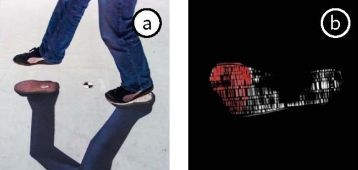A New Approach to Tracking People and Objects
Based on a Pressure-Sensing Floor

GravitySpace is a new approach to tracking people and objects indoors. Unlike traditional solutions based on cameras, GravitySpace reconstructs scene data from a pressure-sensing floor. While the floor is limited to sensing objects in direct contact with the ground, GravitySpace reconstructs contents above the ground by first identifying objects based on their texture and then applying inverse kinematics.
Smart rooms support users by offering not only a series of convenient functions, like home automation, but also by acting pro-actively on the user’s behalf. To this end, such rooms need to know their own geometry as well as the people and their actions within it.

We propose to use high-resolution pressure-sensitive floors as new approach for tracking people and furniture in smart rooms.
While the floor is limited to sensing direct contact with its surface, we can conclude what takes place in the room above, such as users’ poses or collisions with virtual objects.

Pressure-based sensing on the floor offers four potential benefits over camera-based solutions: (1) it provides consistent coverage of rooms wall-to-wall, (2) is less susceptible to occlusion between users, (3) allows for the use of simpler recognition algorithms, and (4) intrudes less on users’ privacy.

To explore our approach and to demonstrate our vision true to scale, we have created an 8 m² back-projected floor prototype, termed GravitySpace, a set of passive touch-sensitive furniture, as well as algorithms for identifying users, furniture, and poses.
GravitySpace is a research project by Alan Bränzel, Daniel Hoffmann, Marius Knaust, Patrick Lühne, René Meusel, and Stephan Richter supervised by Christian Holz, Dominik Schmidt, and Patrick Baudisch at the Human Computer Interaction Lab at Hasso Plattner Institute.
YouTube
Related Publications
- Bränzel, A., Holz, C., Hoffmann, D., Schmidt, D.,
Knaust, M., Lühne, P., Meusel, R., Richter, S., and Baudisch, P.
GravitySpace: Tracking Users and Their Poses in a Smart Room
Using a Pressure-Sensing Floor
In Proceedings of CHI 2013, pp. 725-734 (best paper honorable mention)
PDF | YouTube
In the Press
- Touch-sensitive video-screen floor is in step with you. In New Scientist, January 23, 2013.
- GravitySpace shows how floors will smarten up. In Phys.org, January 24, 2013.
- Pressure-sensing GravitySpace floor adds new dimension to the smart home. In Gizmag, January 27, 2013.
- Researchers aim to revolutionize the home with GravitySpace, a video smartfloor. In Geek.com, January 27th, 2013.
- Could you live in a house filled with smart floors? In Digital Trends, January 28th, 2013.
- Eigenheim 2.0: Interaktiver Video-Fußboden. In pressetext, February 2nd, 2013.
- Der Boden denkt mit. In New Scientist (Germany), February 2nd, 2013.
- Watch: A Crazy Floor Senses And Mirrors Your Every Move. In Co.DESIGN, February, 11th 2013.
Further Links
- Download high-resolution images. All images Copyright © 2013 Hasso-Plattner-Institut.
Supported by
2 thoughts on “GravitySpace”
Comments are closed.